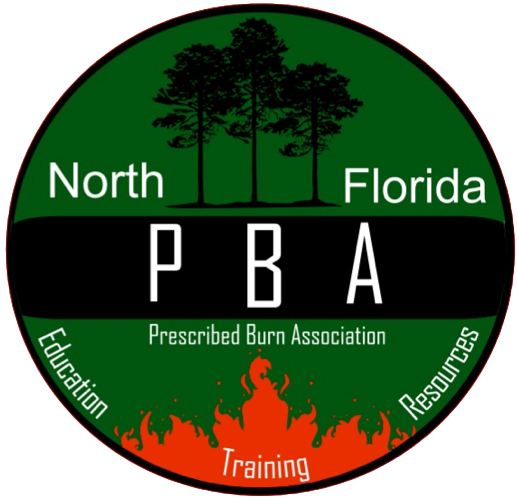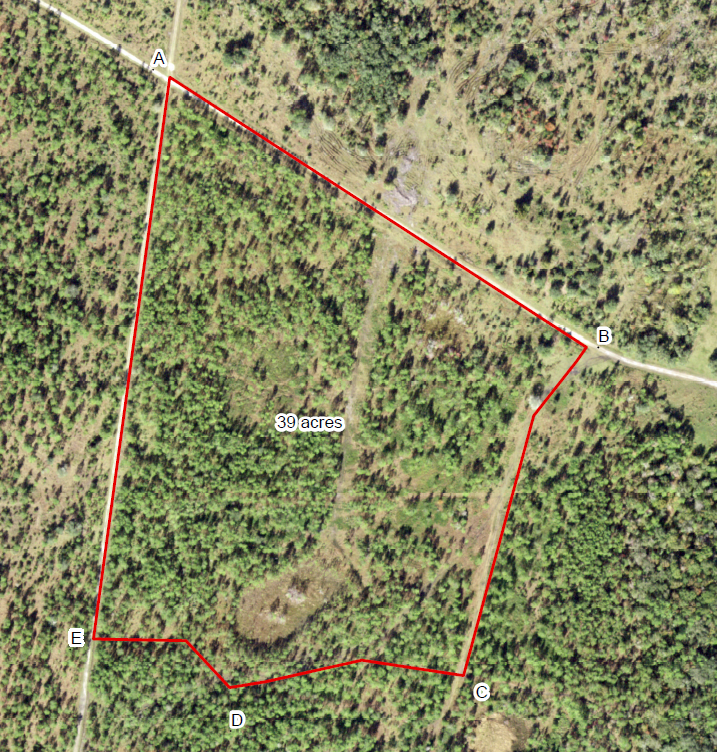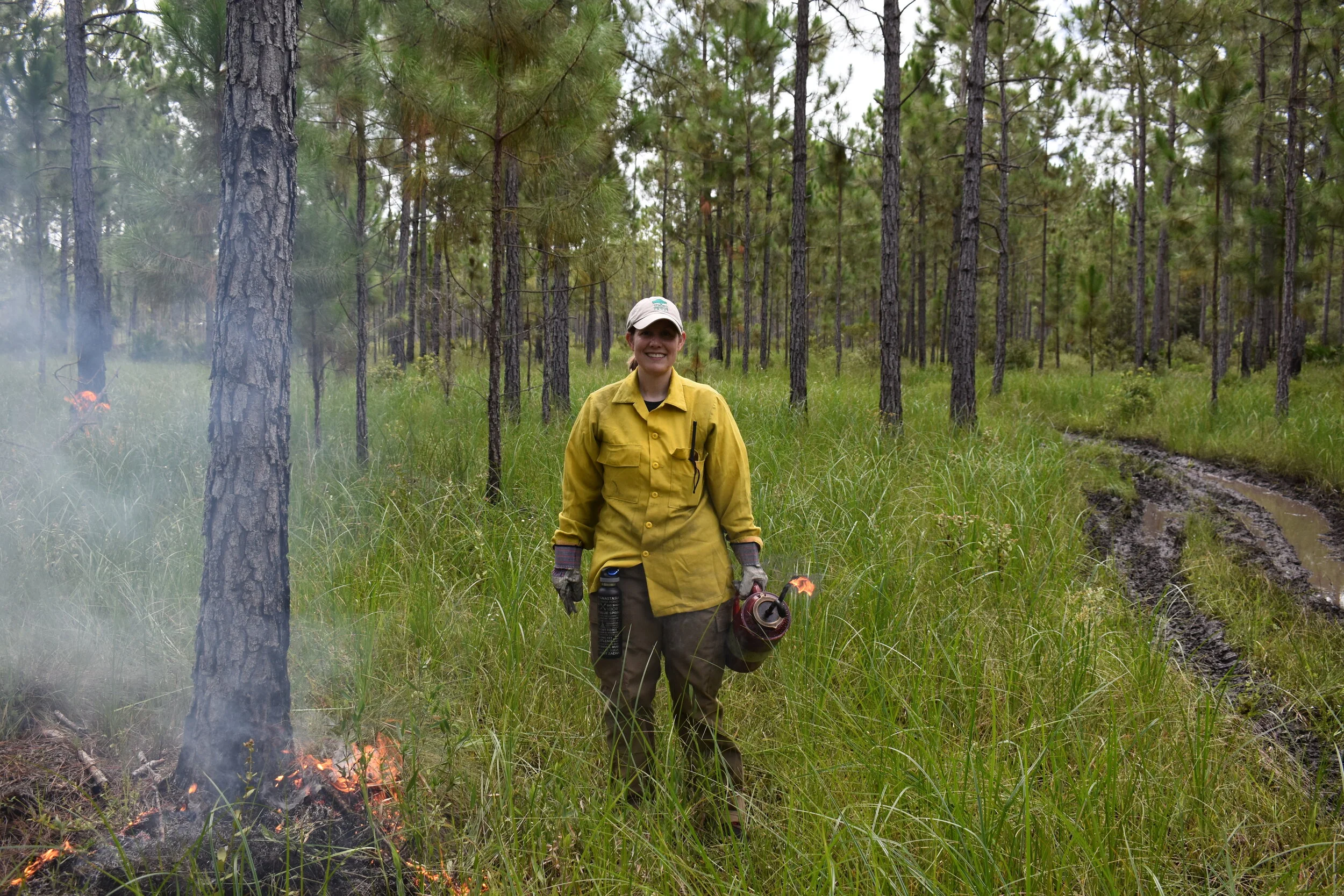Behind the Burn: Experiencing Prescribed Fire Up Close
By Heather Obara, ACT’s Associate Director
As part of the Alachua Conservation Trust (ACT) Communications Team, I often engage in conversations and educational outreach about different types of land management techniques that ACT utilizes to manage conservation land. Prescribed fire — also referred to as a controlled burn — is one of several techniques that helps ACT restore forests in our area. Sandhill ecosystems greatly benefit from the application of prescribed fire, which helps reduce invasive species, limits fuel on the ground to reduce the potential impacts of wildfires, and promotes the growth of fire-dependent native species like longleaf pine trees. Prescribed fire is an important part of ACT's land management work, and though I often talk about the concept of prescribed fire and its benefits to our area, I had never experienced a prescribed fire up close.
Recently I had the opportunity to shadow ACT’s Fire Team during a controlled burn on private property in Volusia County. The burn was conducted with assistance from the North Florida Prescribed Burn Association (NFPBA), Florida Fish and Wildlife Conservation Commission (FWC), and UF Institute for Food and Agricultural Sciences (IFAS). FWC routinely assists the NFPBA and its burn team on controlled burns. They also provide valuable wildlife management advice to landowners. Not only did this give me the opportunity to watch our fire team in action, but I was also able to experience prescribed fire first hand as an active participant, giving me a greater understanding of fire and its importance for conservation.
I'd like to take you on a journey through my day on a prescribed fire with highlights of some of the things that I learned during this experience:
Upon arriving at the private property where the burn was to take place, we met with the landowner as well as our partners assisting with the burn that day. We were then assisted by a biologist from the FWC, as well as an individual member of the NFPBA. Wendy Mussoline, the Volusia County Agricultural Extension Agent for UF IFAS, also documented the burn. You can read her account here and view a video of the “cracklin' fire” down below.
After loading our gear into the utility vehicles, we gathered for a pre-burn briefing with ACT's Private Lands Stewardship Specialist and Burn Boss, Barry Coulliette. During our briefing, we viewed a map of the area we would be burning and reviewed the burn prescription, which describes the location, expected weather conditions, objectives of the burn, site conditions, and outlines a plan for burn activities including any emergencies. The area, or unit, we would be burning is utilized for cattle grazing and the burn objective would be ecological restoration to promote the growth of vegetation.
Aerial map of the burn unit.
One of the most important conditions for burns is weather, which can often change quickly and impact the path of fire and the direction of smoke from the burn. For that day’s burn, we expected milder winds from the northeast in the morning at around 6 MPH, with a slight increase and shift to the east/southeast in the afternoon. At 61%, the relative humidity was a bit higher than ideal conditions which are typically 35-55%, meaning the team may need to use more ignition points. After completing our briefing, we split into teams and set out on a tour of the 39-acre unit we would be burning.
For the burn, I was paired with Joe Nieves, one of ACT's former land management specialists and fire team members. Following a UTV tour to familiarize ourselves with the burn unit, we parked our vehicles along a firebreak — a strip of ground that helps prevent fire from progressing outside of the burn unit — and began to prepare our gear for the burn while Barry and the landowner lit a test fire nearby. If the test fire shows any indications that the burn will not go as planned, the day is done. In our case, we were easily able to light the test fire, and it appeared to behave as anticipated.
Barry Coulliette (right) and the landowner lighting a test fire.
Before we could begin the burn, we needed to ready our drip torches, which are used by fire professionals to ignite the fire. Here we have Joe carefully demonstrating how to set up the drip torch so that it is ready to use.
Joe Nieves demonstrating how to ready a drip torch.
With our drip torches readied and the test fire a success, we split into two groups of 3-4 people. Both groups would work out from the center of the unit away from each other with each person in that group spread about 30-feet apart. ACT's Rachel Townsend was set up closest to the firebreak at the front of the unit and led us off, lighting her torch on the test fire and moving in a line outward from the center while igniting wiregrass, palmettos, and other vegetation that would help sustain the fire. Anything with brown or dead leaves or covered in fallen pine needles were good candidates. With staggered starts, the rest of us followed. As this was my first time on a controlled burn, I was paired with Joe, who demonstrated lighting techniques and allowed me to give it a try as well. First, we lit point source fires, which entails applying small spots of fire that eventually burn together at a lower intensity. In areas with more wiregrass, Joe demonstrated a strip fire by holding the drip torch down at an angle, allowing a small amount of fuel to drip down the wick and light a line of fire along the ground. Here are a few photos of Joe and I lighting point source fires.



As we moved across our assigned area, Joe also explained different fire techniques. A headfire burns with the wind and spreads faster, while backing fires burn into the wind, and flank fires burn parallel to the direction of the wind, neither burning with or against it. In the first half of the unit, we lit point source fires along with some strip headfires. As we finished working our way towards the firebreak to the north of the burn unit, Barry radioed the team about the potential of an approaching storm. After a quick water break, we picked up the pace as we worked our way back to the center of the unit, igniting new areas and keeping in contact on our radios about the approaching storm clouds.
Observing the fire as it moves through the burn unit.
Once we completed ignition on the front half of the unit, we took a short break to hydrate, eat lunch, and refuel our drip torches. The storm clouds headed off in another direction without impacting the burn, so we moved our UTVs to the south side of the unit along another firebreak to begin burning the back half. This time, I was able to work my way across the unit and apply some of the knowledge I had just learned. Setting headfires and then later flank fires, we completed ignition of the entire unit by mid-afternoon. Afterwards, we monitored the flames for a bit to make sure the burn was going as planned.
Wendy’s video of the “cracklin’ fire.”
The final stage of a prescribed fire is known as mop up, in which fire professionals extinguish the fire in places to keep the flames from increasing or leaving the unit overnight as the fire runs out of fuel and slowly burns out. As we drove along the firebreaks one last time, we kept an eye out for higher intensity flames near the edge of the unit. Because the flames and intensity of the burn had remained low, a typical mop-up was not needed, allowing us to pack up and head out. When we returned to ACT's headquarters, we grouped up one last time for an After Action Review (AAR) where we discussed how the day went and what we learned.
Learning a lot on my first prescribed fire.
When I look back at my experience on a controlled burn for the first time, I realize how much preparation goes into these efforts. Without proper planning, constant communication, and near-perfect conditions, a prescribed fire can easily go wrong. But thanks to prescribed fire professionals, who train extensively and work together to accomplish these burns, Florida's forests are being safely restored with prescribed fire. As an active participant on a controlled burn, I now have a much more in-depth understanding of the process, all of the moving pieces, and how delicate it can be when working to mimic a natural process like fire. I hope that recounting my experience and sharing some of what I learned has inspired you to learn more about prescribed fire and its benefits as well.
I have included a few links below to resources that were helpful to me and may also be helpful to you too. And if you are a landowner interested in learning more about how prescribed fire can benefit your land, consider becoming a member of the North Florida Prescribed Burn Association here.
Additional Resources:
WhyPrescribedFire.org (Tall Timbers)
Steps of a Prescribed Burn (Florida State Parks)
Fire Techniques (NC State)
What Happens to Wildlife During a Prescribed Fire Video (Alachua Conservation Trust)
Learn about the North Florida Prescribed Burn Association (NFPBA)









